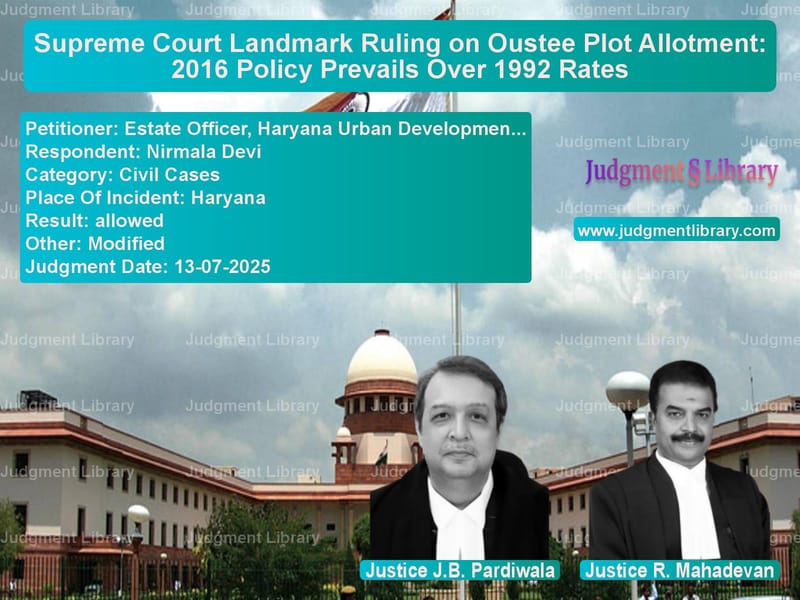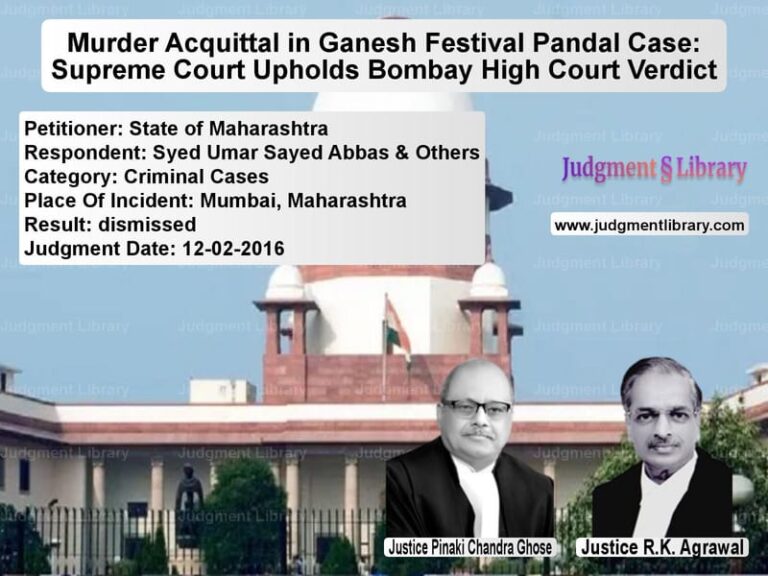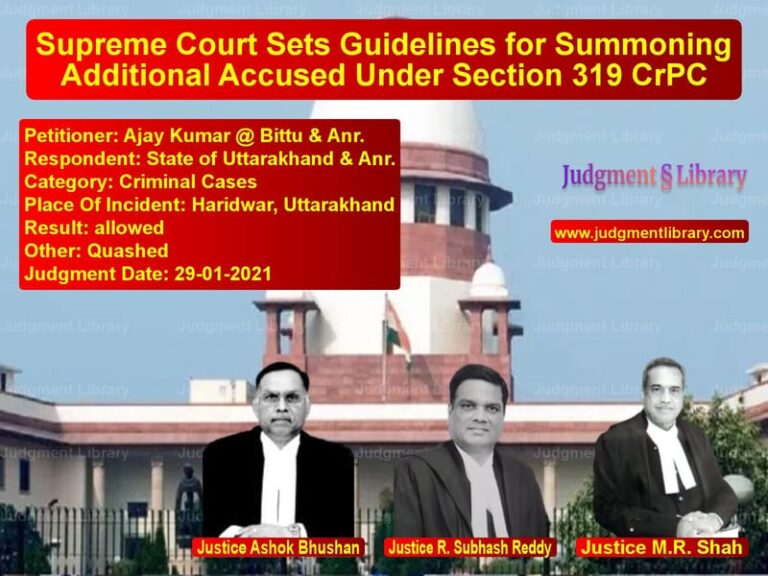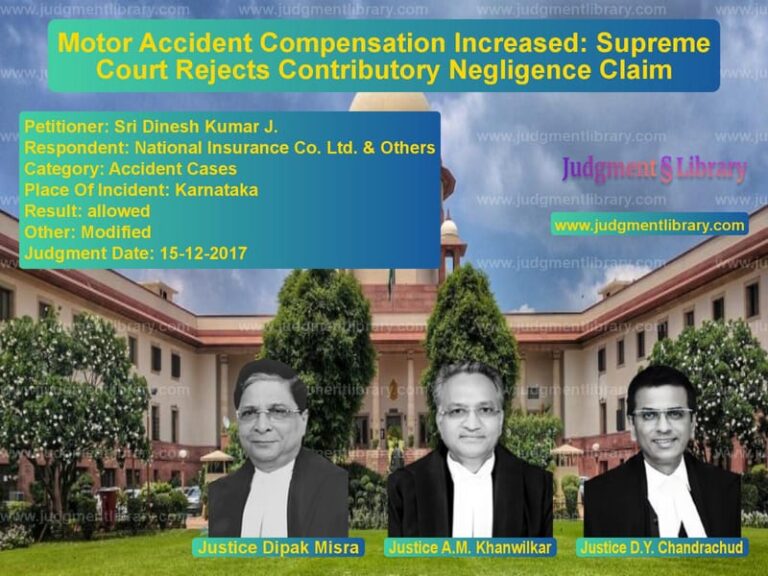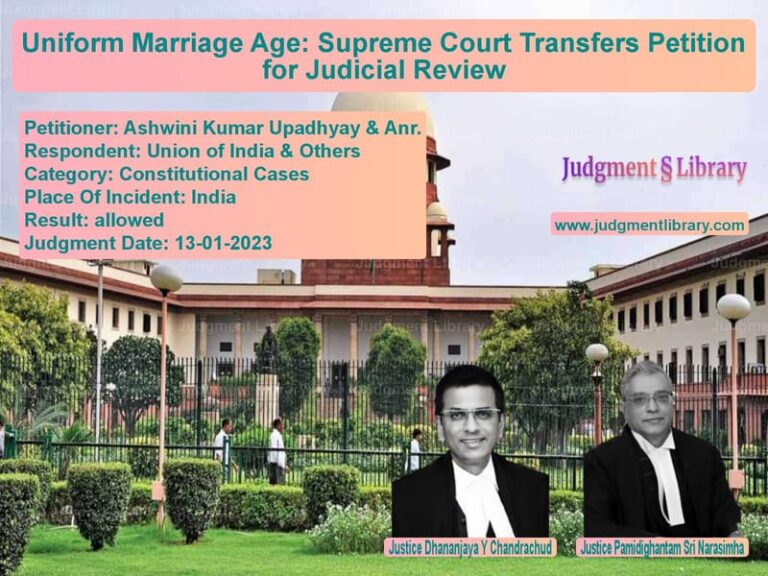Supreme Court Landmark Ruling on Oustee Plot Allotment: 2016 Policy Prevails Over 1992 Rates
In a landmark judgment that brings clarity to decades of litigation surrounding land acquisition and rehabilitation policies, the Supreme Court of India delivered a comprehensive verdict on July 14, 2025, addressing the rights of oustees—people whose land has been acquired for public purposes. The case involved multiple appeals concerning the Haryana Urban Development Authority’s (HUDA) policies for allotting residential plots to those whose lands were acquired for urban development. At the heart of the dispute was whether oustees were entitled to plots at 1992 rates under the old policy or had to accept the revised 2016 policy with higher prices. The Supreme Court’s ruling not only resolves this specific conflict but also provides important guidance on the interpretation of legal precedents, the maintainability of suits for mandatory injunction, and the broader principles governing land acquisition and rehabilitation in India.
The legal battle had its origins in land acquisition proceedings dating back to 1989-1992, when the Haryana government acquired lands for developing residential sectors in urban areas. To mitigate the hardship faced by landowners, HUDA introduced a policy in 1992 offering allotment of residential plots to oustees at preferential rates. However, what followed was extensive litigation spanning nearly three decades, with oustees filing suits under Section 39 of the Specific Relief Act, 1963, seeking mandatory injunction for enforcement of the 1992 policy. The core controversy centered around whether oustees who hadn’t applied in the prescribed format with earnest money deposits as required by the 1992 policy could still claim benefits under that policy, particularly at the lower 1992 rates.
The appellants, represented by Estate Officer, Haryana Urban Development Authority and others, argued vehemently before the Supreme Court that the oustees had failed to comply with essential conditions of the 1992 policy. Ms. Aishwarya Bhati, the learned Additional Solicitor General appearing for the appellants, submitted that ‘only those oustees are entitled to seek allotment of a plot under the policy who had filed appropriate application in a prescribed format, seeking allotment of plot with the deposit of the requisite earnest money.’ She emphasized that ‘from the perusal of the brochure so issued in 1992 and in 2000, it is evident that the application form is to be purchased upon payment as the same is serial no. ed also.’ The appellants maintained that since the respondents had not submitted applications in the prescribed format with earnest money, they couldn’t claim entitlement to plots under the oustee policy.
On the crucial issue of pricing, Ms. Bhati argued that ‘the normal allotment rate would be the rate advertised by HUDA in pursuance of which applications are invited from the general public and the oustees, in pursuance of which the plots are allotted.’ She contended that the respondents’ failure to submit proper applications meant they couldn’t demand plots at 1992 rates. The appellants also raised significant concerns about the maintainability of the suits, noting that ‘the suits filed by the individual respondents under Section 39 of the Specific Relief Act, 1963 were not maintainable, more particularly, when none of the respondents had applied for the plot in a prescribed format with deposit of earnest money.’ They pointed out that ‘admittedly the acquisition proceedings concluded in 1992 upon passing of the award and the State Government issued and advertisement inviting the application for allotment of plot under the oustees quota in 1992 itself but the respondents instituted Civil suit after 14-20 years which is barred by Article 113 of the Limitation Act where the limitation of 3 years for the institution of the suit has been provided.’
The respondents, represented by oustees including Nirmala Devi and others, strenuously opposed these arguments. Dr. Surender Singh Hooda, the learned senior counsel appearing for the respondents, submitted that ‘this Court may not interfere or rather disturb the concurrent findings recorded by three courts below.’ The respondents heavily relied on the Supreme Court’s earlier decision in Brij Mohan and Others v. Haryana Urban Development Authority reported in (2011) 2 SCC 29, arguing that their entitlement to plots at 1992 rates was squarely covered by this precedent. The principal argument advanced by the respondents was that ‘if the policy of 2016 is applied it would impose a substantial financial burden on the oustees.’ They maintained that they were ready and willing to deposit the amount of Rs. 863 per sq. yd. but the demand of the revised rate of Rs. 1122 per sq. yd. was not tenable in law.
The Supreme Court, after extensive hearing and examination of the record, delivered a judgment that carefully analyzed the legal principles involved. The Court began by examining whether the case was indeed governed by the Brij Mohan precedent as argued by the respondents. In a detailed analysis of how to identify the ratio decidendi (the legal principle underlying a decision) of a case, the Court applied various tests including the ‘Inversion Test’ propounded by Professor Eugene Wambaugh. The Court observed that ‘not every observation in a judgment of this Court is binding as precedent. Only the ratio decidendi or the propositions of law that were necessary to decide on the issues between the parties are binding.’ After applying these tests, the Court concluded that ‘the case on hand is not covered by the dictum as laid in Brij Mohan (supra). We find it difficult to accept the vociferous submission canvased on behalf of the respondents that so far as the rate at which the allotment is to be made is squarely covered by the dictum as laid in Brij Mohan (supra).’
The Court explained that in Brij Mohan’s case, the land-loser had made an application in 1990 for allotment of plot, and a direction was issued by the Court in 1992, but HUDA delayed the allotment. In those specific circumstances, the Court had ordered that the rate initially offered should be charged. However, the Court clarified that ‘the dictum as laid in Brij Mohan (supra) should not be read as laying down an absolute proposition of law that the “normal allotment rate” in all circumstances shall be paid when the sector is first floated for sale. As a matter of fact, the normal allotment rate would be the rate advertised by HUDA in pursuance of which the plots are allotted.’ This distinction proved crucial in the Court’s reasoning.
The Court also examined the maintainability of suits filed under Section 39 of the Specific Relief Act, 1963. The provision states: ’39. Mandatory injunctions.—When, to prevent the breach of an obligation, it is necessary to compel the performance of certain acts which the court is capable of enforcing, the court may in its discretion grant an injunction to prevent the breach complained of, and also to compel performance of the requisite acts.’ The Court elaborated on the conditions for granting mandatory injunction, noting that ‘the plaintiff in a suit instituted by him under Section 39 of the Act 1963 is obliged to satisfy the court with appropriate pleadings and cogent evidence that the defendant is committing breach of a particular obligation which is binding on him and there are certain acts which are capable of being enforced by the court.’ The Court observed that ‘when the scheme in question specifically provides that an oustee shall file an application in a specified format with deposit of the requisite amount towards earnest money then it is a part of the obligation on the part of the oustee to do so before he calls upon the State to allot the plot in accordance with the terms of the scheme.’
On the issue of limitation, the Court noted with concern that ‘there is no explanation worth the name why it took 14-20 years for the plaintiffs to institute their respective suits for mandatory injunction under Section 39 of the Act 1963.’ The Court observed that ‘whether Article 58 of the Limitation Act would apply or Article 113 of the Limitation Act, the period of limitation would be 3 years. By no stretch of imagination, it can be said that the case on hand is one of recurring cause of action so as to bring the suit within the period of limitation though instituted almost after a period of 14-20 years.’ The Court indicated that it could have dismissed the suits on the ground of limitation alone but chose to grant the respondents some relief in light of the circumstances.
In its final analysis, the Court made significant observations about the broader principles of land acquisition and rehabilitation. The Court noted that ‘acquisition of land does not violate any constitutional/fundamental right of the displaced persons. However, they are entitled to resettlement and rehabilitation as per the policy framed for the oustees of the project concerned.’ The Court further observed that ‘rehabilitation is not a recognized right either under the Constitution or under the provisions of the Land Acquisition Act. Any beneficial measures taken by the Government are, therefore, guided only by humanitarian considerations of fairness and equity towards the landowners.’ The Court emphasized that ‘ordinarily, rehabilitation should only be meant for those persons who have been rendered destitute because of loss of residence or livelihood as a consequence of land acquisition. In other words, for people whose lives and livelihood are intrinsically connected to the land.’
The Supreme Court summarized its conclusions with specific directions: ‘The respondents are not entitled to claim as a matter of legal right relying on the decision of Brij Mohan (supra) that they should be allotted plots as oustees only at the price as determined in the 1992 policy. The respondents are entitled at the most to seek the benefit of the 2016 policy for the purpose of allotment of plots as oustees.’ The Court granted four weeks time to all respondents to prefer online applications with deposit of requisite amount under the 2016 policy and directed the authorities to process these applications within eight weeks. The Court also imposed important conditions to prevent misuse, stating that ‘the State of Haryana as well as HUDA shall ensure that land grabbers or any other miscreants may not form a cartel and try to take undue advantage of the allotment of plots.’ Additionally, the Court directed that ‘the allotee shall not be entitled to transfer the plot to any third party without the permission of the competent authority and in any case not within five years from the date of the allotment.’
This judgment represents a significant development in the jurisprudence surrounding land acquisition and rehabilitation in India. It clarifies the limited scope of rehabilitation rights, emphasizes the importance of complying with procedural requirements in government schemes, and provides guidance on how courts should approach the interpretation of precedents. The decision balances the rights of oustees with the practical realities of urban development, while cautioning against the potential for litigation arising from poorly designed rehabilitation schemes. The Supreme Court’s ruling brings legal certainty to a long-standing dispute and establishes important principles that will guide future cases involving similar conflicts between individual rights and public development projects.
Petitioner Name: Estate Officer, Haryana Urban Development Authority and Ors..Respondent Name: Nirmala Devi.Judgment By: Justice J.B. Pardiwala, Justice R. Mahadevan.Place Of Incident: Haryana.Judgment Date: 13-07-2025.Result: allowed.
Don’t miss out on the full details! Download the complete judgment in PDF format below and gain valuable insights instantly!
Download Judgment: estate-officer,-hary-vs-nirmala-devi-supreme-court-of-india-judgment-dated-13-07-2025.pdf
Directly Download Judgment: Directly download this Judgment
See all petitions in Property Disputes
See all petitions in Compensation Disputes
See all petitions in Judgment by J.B. Pardiwala
See all petitions in Judgment by R. Mahadevan
See all petitions in allowed
See all petitions in Modified
See all petitions in supreme court of India judgments July 2025
See all petitions in 2025 judgments
See all posts in Civil Cases Category
See all allowed petitions in Civil Cases Category
See all Dismissed petitions in Civil Cases Category
See all partially allowed petitions in Civil Cases Category

